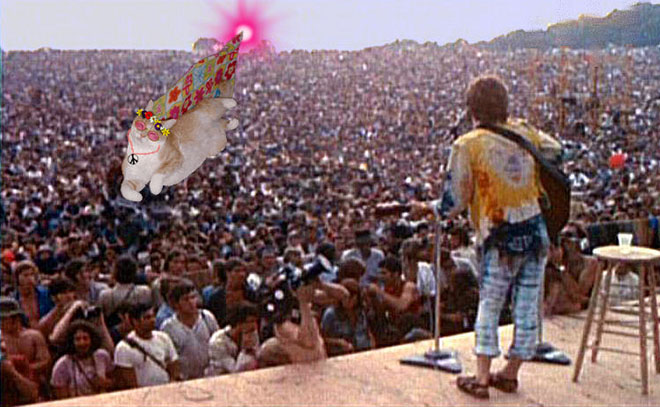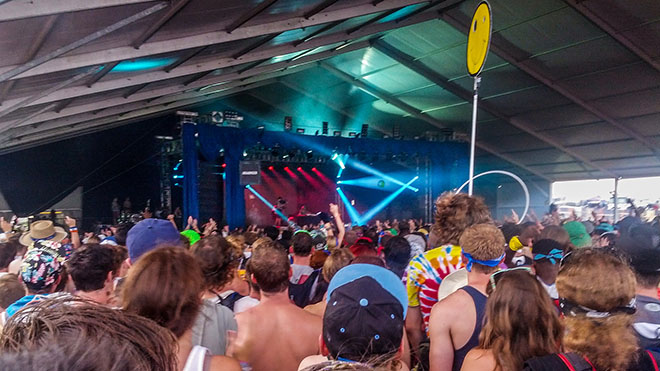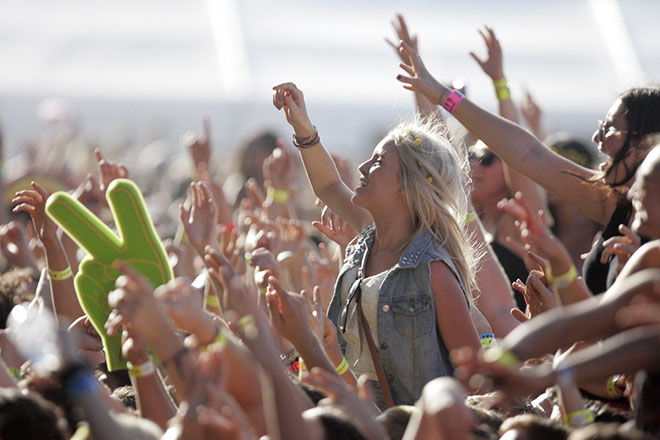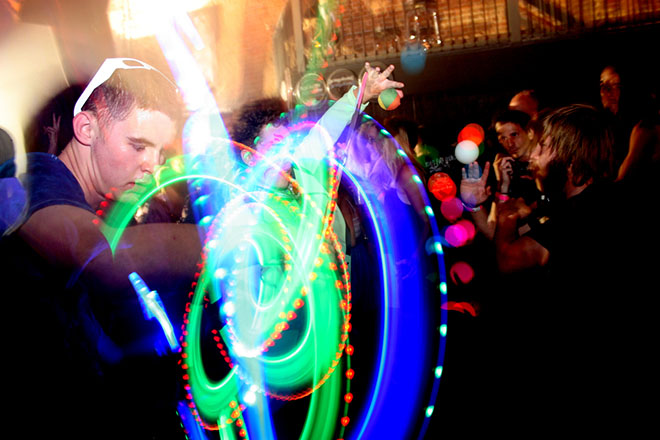At the bottom of a dirt path marked by a yellow question mark painted crudely onto a circular piece of wood, a soothing voice can be heard: “The power is in the exhale. Release yourself. Lose yourself.”
“Now,” the voice says, “Feel your heart move into your neighbor’s heart. Now bring it back to yourself once more.” It is 1 p.m. at the What the Festival in Dufur, Oregon, and an afternoon session of “Good Times Yoga” is being held in the Illuminated Forest. Trek deeper into the Illuminated Forest and you’ll find a Japanese tea lounge; a makeshift Buddhist temple; and various art installations, like a wooden unicorn, a life-size stag made only of mirrors, and a massive dream catcher. Emerge from the trees to discover a hookah lounge furnished with vintage couches and coffee tables. Continue further into the middle of the festival—passing the organic coffee vendors and the fire twirlers until you get to the pool party helmed by a chilled out DJ—and you’ll be reminded that female toplessness is technically legal, that not everyone makes wise tattoo decisions, and that questions like, “Who here is on acid?” are sometimes answered with resounding cheers and a sea of raised hands.
It’s difficult to tell if the What the Festival, abbreviated as WTF, which includes stage names such as the “Effin’ Stage,” the “OMG Lounge,” and the “Late-Option Lounge” (or “LOL Stage”), is making an ironic stab at mainstream culture or a clumsy attempt at cultural relevance, but it is clear that the nascent festival in rural Oregon sees itself as an alternative to better-known and more popular summer music and arts festivals (Coachella, Sasquatch, Lollapalooza, Bonnaroo, and the Electric Daisy Carnival).
The hipster is able to play the role of the bohemian while simultaneously wielding the resources of the bourgeois.
The summer music and arts festival has long been a hub for fringe culture and a jumping off point for political and social protests. Woodstock, the quintessential counterculture festival in upstate New York, was a definitive moment for racial and sexual equality. It marked the rise of hippie culture in the Baby Boomer generation and sparked a countercultural trend throughout the world. England also took part, establishing its own hippie culture at the Isle of Wright Festival in 1970, a year after Woodstock, where bands like Led Zeppelin and Ten Years After attracted an estimated 600,000 attendees, breaking the record for largest musical event of its time. Three years later, Australia hosted the 10-day Aquarius Festival in Canberra, where rock musicians and experimental theater actors performed side by side in what’s been called “the launching pad for Australia’s hippie movement.”
Today, some modern festivalgoers are looking to return to these countercultural roots. “I feel like there are a lot of manufactured events that have gone mainstream and are really materialistic,” says Craig Erickson, a writer from Portland, Oregon, who attended the What the Festival for the first time this year. “I wanted to come out here because I heard it was a lot more low-key. I feel like you can get weird here. It’s a different mindset.” But, despite Erickson’s enthusiasm, the age of the counterculture festival seems to have long since passed.
In Music, Power, and Politics, Annie Janeiro Randall, an Oxford-educated musicologist, argues that the first hippies—“proto-hippies”—emerged in Germany at the beginning of the 20th century, and used the works of Nietzsche, Goethe, and Hesse to support their rejection of urbanization and desire to return to nature and spiritual life. The movement, known as Wandervogel, or “migratory bird,” was introduced to the United States in the 1950s when many of these proto-hippies left Germany after World War II, moving especially to areas with warm climates like southern California. The beatniks, led by Jack Kerouac and Allen Ginsberg, helped propel hippie culture popularity in the U.S. in the 1960s, and, after 1967, when the three-day Monterey Pop Festival marked the beginning of the “Summer of Love,” hippie culture became a well-known subculture in American society.
It became so popular, in fact, that a July 1967 issue of Time magazine ran a cover story entitled “Youth: The Hippies,” which summed up the hippie ethos this way:
Do your own thing, wherever you have to do it and whenever you want. Drop out. Leave society as you have known it. Leave it utterly. Blow the mind of every straight person you can reach. Turn them on, if not to drugs, then to beauty, love, honesty, fun.
However, in 1969, when Charles Manson, who was viewed by many as a hippie (a dropout musician living in California), orchestrated the murders of actress Sharon Tate and Leno and Rosemary LaBianca, the world quickly grew disenchanted with hippie culture. The televised trial of the Chicago Seven (a group of seven people who conspired to cross state lines to incite a riot in protest of President Lyndon Johnson’s Vietnam War policies) also demonstrated the radical side of hippies to a mass American audience and led to their further social exclusion. By the mid-’70s, hippie culture had all but fizzled out.
Those who still identified with the term hippie became nomads, and for those who were still a part of hippie culture or simply wanted to live by hippie values, festivals became the predominant way to meet, meditate, create art, experiment with drugs and sexuality, and listen to music. Until very recently, this subculture has continued to thrive, albeit in smaller numbers than 50 years ago, meeting at a variety of countercultural events held throughout the country.

Daftastic Data at Woodstock, 1969. (Photo: Suzi Duke/Flickr)
Burning Man, a week-long event where participants build a city in Nevada’s Black Rock Desert, is perhaps the best example of the modern counterculture festival. Although Burners may not refer to themselves as hippies, most fancy themselves counterculturalists. The event, which is home to all-night dance parties and massive art installations including the eponymous effigy that’s burned at the end of the week, started as essentially a temporary commune where goods and services were traded in a “gift economy”: favors unconditional, monetary exchanges irrelevant. It was a direct rebuttal to the hegemony of capitalism and to corporate sponsorship, the festival version of Occupy Wall Street, a pushback against the type of world presaged by David Foster Wallace’s Infinite Jest, in which everything is mediated by advertising and branding.
Recent issues with ticket sales (where single buyers bought up dozens of tickets and immediately sold them off at rates too expensive for most Burning Man regulars) and the fact that Silicon Valley CEOs have begun shelling out for guided VIP Burning Man “experiences” (creating socioeconomic tiers at the festival), however, have led to the degradation of the festival’s original countercultural values.
Likewise, the five-day Glastonbury Festival near Pilton, Somerset, England, which began as a “free festival” where everything was free of charge in exchange for volunteering, now costs £215 and is sponsored by the mobile phone company Orange. So too Lightning in a Bottle, a “transformational” festival meant to inspire “social cohesion” in California’s Angeles National Forest lost much of its countercultural cachet when a sophisticated police sting that bordered on entrapment led to the arrests of 58 attendees at last year’s festival for drug deals, mainly for the sale of small amounts of marijuana.
Long gone are the painted Volkswagen buses, talk of “free love,” and shoulder-length hair for men, but it’s only recently that the festivals associated with those things have also begun to disappear, replaced by a new breed of festival that’s tailored to a different group entirely: hipsters.

Bonnaroo. (Photo: Matthew Tosh/Flickr)
Hipsters, who intentionally and ironically pervert supposed mainstream values, oftentimes share the external appearance of hippies: the long beards, the psychedelic drugs, and the rejection of “popular culture” from Katy Perry to luxury cars. Yet a hipster is not the same as a hippie for he is not a bohemian, but rather, as New York Times columnist David Brooks writes in Bobos in Paradise: The New Upper Class and How They Got There, a bourgeois–bohemian, or “bobo.” The hipster is able to play the role of the bohemian while simultaneously wielding the resources of the bourgeois.
What has caused the modern destruction of the countercultural festival—and, by extension, the systematic degradation of the modern counterculture movement—is not so much dubious police raids or overpriced tickets, but the fact that modern festivalgoers genuinely believe they are taking part in something countercultural while they are in fact participating in the mainstream. Hipsters are not hippies, and to think that camping for a few days without showers, smoking weed and popping Molly (the popular methylone-based drug—essentially a distilled form of ecstasy), and living without responsibilities save for which musician to see next makes one a cultural revolutionary is an inherently flawed stream of logic.
Although the hipster believes he is embracing counterculture and anti-establishment through his rejection of the mainstream, he is in fact less intent on social change and more keen on getting ahead of and setting cultural trends—even as these trends are often mediated through capitalism. Implicit, yet nonetheless important “rules” of hipsterdom include drinking the “right” brand of beer, such as Pabst Blue Ribbon (as it was once associated with the blue-collar worker) and the importance of wearing the “right” brand of sunglasses ($200 Ray-Bans? Sure! Equally pricey Persols? So gauche).
Such care for manufactured trends and material goods is antithetical to the counterculture ethos. The reason the hipster is so adamantly pursued by corporations, brands, and commercial interests is that as an upper-middle-class, 18- to 35-year-old, he is not only a part of the most desired demographic but also a willing consumer, something the hippie never was.

Future Music Festival, 2013. (Photo: Eva Rinaldi/Flickr)
At this year’s South by Southwest festival in Austin, Texas, or SXSW, which combines concerts with a film competition and art installations, the comedian Jimmy Kimmel sent his crew to ask festivalgoers if they had heard of made-up musical acts such as “Contact Dematitis,” “Neil Patrick Harassment,” and “DJ Heavy Flow.” Too ready to be perceived as up on the latest musical trends, the interviewees responded empathically in the affirmative: “[I’ve] heard a couple songs” from DJ Heavy Flow’s album, The Toxic Shock Experience, says one girl; “I heard it, but I’m not really into it,” says another guy on the rap-country music of the fictional Willie Nelson Mandela. It is entertaining and funny to watch these people caring so much about trends, about what other people think, and about being perceived as cool, but it is also an obvious line in the sand between hipsters and counterculturalists.
But like many dying subcultures (even those who read physical books still have a few surviving bookstores to shop in) there may be a few last bastions of hope for the counterculturalist.
Two years ago I wondered if the inaugural What the Festival could become this generation’s counterculture festival. This year’s event attracted another steady crowd from the West Coast; Vancouver, Seattle, Portland, and San Francisco were all represented. The attendees weren’t quite hipsters but they weren’t quite hippies either: There didn’t appear to be any driving social conscience behind the festival (save for perhaps eco-friendliness—e.g. composting bins, hemp milk), desire to “drop out” of society, or overt motivation to turn people on to “drugs … beauty, love, honesty, [or] fun,” as the Time article wrote of hippies. But based on nearly two-dozen interviews and two years of attendance, it is clear that these festivalgoers aren’t the upper-middle-class twentysomethings looking for a place to prove their coolness bona fides or to try new synthetic drugs, as it tended to be with the attendees I spoke to at Coachella, Bonnaroo, and Sasquatch.
The volunteer-created Counter Culture Festival in Utrecht, Netherlands, and the pagan, new-age Yaga Gathering in Varena, Lithuania, also exist in this nebulous space. Hippie culture may be dying, but a new subculture—a sort of purgatory between hipster and hippie—may be arising.

Electric Daisy Carnival. (Photo: Jim Wall/Flickr)
Even as Burning Man, Glastonbury, and Lightning in a Bottle have begun to succumb to commercialization, and Coachella, Lollapallooza, Sasquatch, Bonnaroo, Firefly, and the Electric Daisy Carnival are wellsprings for hipsterdom and corporate interests, there are some festivalgoers who are unwilling to accept overt advertising and branding or the know-it-all coolness that exists in hipsterdom.
The question is whether these contemporary counterculturalists can maintain their identity in the face of more popular festivals where attendance skyrockets into the hundreds of thousands. For the What the Festival, the Counter Culture Festival, and the Yaga Gathering, having a few thousand attendees is viewed as a success. Yet all new subcultures must start small. And their attendees hold strong convictions about future growth.
“We’re a part of this thing called the neo-geo Renaissance,” says Kyle O’Neil, an independent publisher from Oregon’s Lincoln City Coast. “This is what’s going on all around us: a Renaissance. There’s been many of them, and every single one of them has led with art.”
Dressed in a rainbow tank top, O’Neil paused to finish practicing his fire staff twirling routine. “We’re finding that path.”




